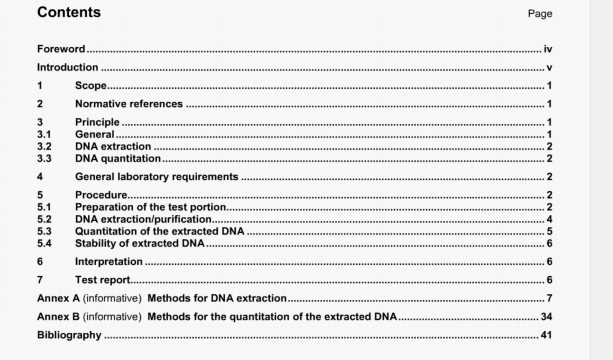ISO 21571 pdf download – ISO 21571 pdf Foodstuffs —Methods of analysis forthe detection of genetically modified organisms and derived products —Nucleic acid extraction.
Acust the pH to 5,2 with glacial acetic acid. Do not autoclave If necessary, filler through a 0,22 pm filter &1.1.6 Apparatus and equipment
Usual laboratory equipment and, m particular, the follcing.
A.1.1.6.1 Centrifuge, capable of achieving a minimøii acceleration of I0000g, In some steps a refrigerated centrifuge is requwed.
A.1.1.6.2 Water bath or Incubator, wcwkrg ii a temperature range Iron, 60 C to 70 C.
A.1.1.63 Vacuum dryer (optional).
&1.1.6.4 Freeze dryer (option).
&1.1.6.5 Mixer. e.g. Vortex’2t
A.1 .1.6.6 Reaction vessels, resistant to freezing in liquid nitrogen.
A.1.1.7 Procedure
A.1.1.7.1 General
Once the matrix test portion has been prepared, apply the following DNA extraclionlpunfication protocol. Scale-adaptation of masses and butter volumes is required as a function of the selected size of the test portion
A.1.1.7,2 Extraction procedure
Weigh 0,25 g of the test sample into a microtube.
Add 1,6 ml of extraction buffet (A.1.1.5.18) d, wtien necessary (e.g. In protein-rich matrices), SOpI of proteinase K solution (A.1.1.5.20.) Incubate at 60 C to 70 C. usually for between 30 mm to 2 h (overnight incubation is also possible). Add RNase A (A.1.1,5.21) L4 to a final concentration of 0,1 pglml. Centrifuge at 5000 g for 30 miii and recover the supematant in a fresh tube. Add 1 volume of equilibraled phenol (A.1.1.5.15) to the supematant, then mix gently and thoroughly. Centrifuge at 5000 g for 15 mm and recover the upper aqueous phase in a fresh tube. Add I volume of phenol-chloroform isoam1 alcohol (A.1.1.5.17) to the supernatant, then mix gently and thoroughly. Centrifuge at 5000 g for 15 min and recover the aqueous phase in a fresh tube. Repeat this step once or more times (depending on the matrix) until the interface between the phases is clean.
Add I volume of chIoroformflsoamI alcohol (A.1.1.5,16) to the supematant, then mix genlfy and thorougNy Centrifuge at 5000 g for 10 mm and recover the upper aqueous phase ii a fresh tube. Repeat, if necessary, until the interface between the phases is dear Mix the supematant with 0,1 volume of potassium acetate solution (A.1.1.5.23.) and 2,5 volumes ci 96% ethanol (A..l.1.5.1), then mix thorougNy by inversion. Incubate for at least 5 mm m Iquid nitrogen, or 1 h at -80 C, or overnight at -20 C. Centrifuge at 10000 g (or up to 13000 g) at 4 C for at least 15 mm. then carefully discard the supematant.
Caref Lily wash the DNA pellet with 2 volumes of 70 % ethanol solution (kl .1.5.22). Centrifuge at 10 000 z to 13000 at 4 C for 15 mm, then discard carefuily the supematant. This step is essential for the removal of the precipitating salts that could interfere with the subsequent analysis (e.g. PCR).
Dry the pellet and re-dissoive It in 100 plot waler or appropriate buffer, e.g. TE buffet (A.1.1.5.19). This is the DNA master stock. Add RNase-A (A.1.1.5.21) up to a final concentration of 0.1 pg/mI.
A,1.1.8 List of examp’es
The method has been successfully applied to extract DNA3) from the following matrices:
acidified soya beans3), dehydrated alfalfa, baby biscuits3), baby milk31, bacteria and spores thereof, barley seeds, beef/pork pate3), beer3), blue cheese, brownies3), canned corn, carrot seeds, cereal bars3). cheese, chicken nuggets, chicory leaves, chicory roots, chocolate cookies3), chocolate paste3), cinnamon cookies3t, compotes. comflakes3t, cracked rice, dessert cream3), dried pea seeds, maize biscuitst. maize feeding oil cakes, rna4ze flour, maize gluten feed, maize seeds, manioc hard pellets for feed, manioc tapioca meat, fresh and cooked31 meats (beef, pork. chicken and turkey), melon fnit pulp, melon seeds, mmoed meat, muesli ingredients3t, muesh3), mung bean sprouts3), oat seeds, potato tuber. rapeseed feeding oil cake, glupacoiza. rapeseed seeds, sausages (slicing3) and cocktail3t (see A,1.2 for an improved extraclion method), schrWtzel, soo.e hoi sir?), soup balls, soya protein in meat preparations3), soya lecithin (raw brown and yellow refined3)), soya sprou&). soya drinks, soya beans, soya bean cream, soya bean feeding oil cake, soya bean tofu, spaghetti sauce31, spelt seeds, sugar beet (dried pulp), sugar beet (fresh root), sugar beet seeds, sunflower seeds, tofu, tomato fresh fruit, tomato purde, tomato seeds, vegetarian hamburger, waffles (with3) and without3) chocolate), wheat bran, wheat flour, wheat gluten feed, wheat seeds, wheat semolina. yoghurt3t (see A. 1.3 for an improved extraction method).
Protocol for starter cultures of fermented sausages.
ISO 21571 pdf download – ISO 21571 pdf Foodstuffs —Methods of analysis forthe detection of genetically modified organisms and derived products —Nucleic acid extraction
